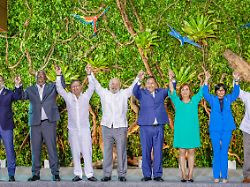Nothing concrete agreed
Critics miss the commitment at the Amazon summit
08/09/2023 05:09 am
For the first time in 14 years, the countries bordering the Amazon are meeting in Brazil. After decades of overexploiting nature, they now want to work more closely together to protect the environment. But the devil is in the details.
The countries bordering the Amazon in South America want to work more closely together on environmental protection in the future. In Belém, Brazil, the heads of state and government of the Amazon countries met for the first time in 14 years for a summit meeting. “It has never been more urgent than now to resume and expand this cooperation,” said Brazilian President Luiz Inácio Lula da Silva at the start of the Amazon Cooperation Organization conference.
The goal of the meeting is to reconcile environmental protection with sustainable economic development and job creation, Lula said. “An Amazon with greener cities, cleaner air, mercury-free rivers and healthy forests. An Amazon with food on the table, decent work and public services available to all. An Amazon with healthier children, welcome migrants, respected indigenous peoples and more hopeful young people. This is our Amazonian dream.”
However, Lula’s vision of the region’s economic development also harbors potential for conflict. Oil production in the Amazon region and in the vicinity of the Amazon estuary is particularly controversial. While the Brazilian President is open to oil production in the region, Colombian President Petro is in favor of curbing the exploitation of fossil fuels.
Indigenous people want more say
The Belém final declaration agreed, among other things, to set up an Amazon Alliance to combat deforestation, a joint air traffic control system against organized crime and better cooperation in the fields of science, finance and human rights. However, critics complain about the lack of binding targets. “The summit addressed the right issues but did not deliver what society, the private sector and academia expect: a set of concrete short- and medium-term actions that can change course,” said Marcelo Furtado of the Coalition for Climate, Forests and agriculture the news portal G1.
Before the start of the summit, representatives of the indigenous communities called for better protection of their land rights and greater participation. “The Amazon is home to millions of people, including indigenous peoples, riverside dwellers and traditional communities,” Lula said. “Our government is committed to protecting the environment and is working with other countries to combat illegal mining, drug trafficking and mercury pollution of our waters.” After deforestation and fire clearing increased sharply during the term of office of right-wing Brazilian President Jair Bolsonaro, Head of State Lula announced when he took office at the beginning of the year that he would strengthen environmental and climate protection again. In recent times, the police have launched large-scale operations against loggers, farmers and illegal prospectors. In Belém, Lula reiterated his pledge to completely stop deforestation in Brazil by 2030.
Recently, deforestation in the Brazilian Amazon region has already decreased significantly. According to preliminary data, deforestation fell by 66 percent in July compared to the same month last year. Between August 2022 and July 2023, an area of 7,952 square kilometers was deforested in the Brazilian Amazon. That was the lowest value in four years.
